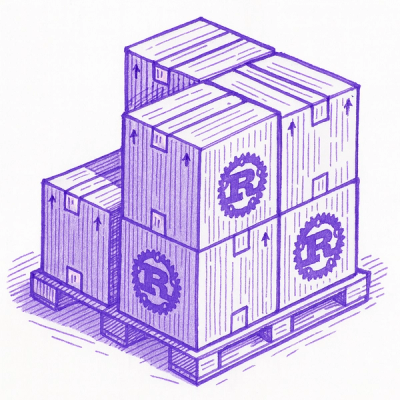
Security News
Crates.io Implements Trusted Publishing Support
Crates.io adds Trusted Publishing support, enabling secure GitHub Actions-based crate releases without long-lived API tokens.
@teckel/vue-barcode-reader
Advanced tools
A Vue.js set of components to scan barcodes and QR codes (or upload images).
The following bug fixes, features & improvements over the abandoned package by olefirenko
The easiest way to use Vue Barcode Reader is to install it with npm or yarn.
npm install @teckel/vue-barcode-reader --save
Or
yarn add @teckel/vue-barcode-reader
The Vue Barcode Reader works out of the box by just including it.
Once a stream from the users camera is loaded, it's displayed and continuously scanned for barcodes. Results are indicated by the decode event.
Composition API example:
<script setup>
import { ref } from 'vue'
import { StreamBarcodeReader } from '@teckel/vue-barcode-reader'
const decodedText = ref('')
const onDecode = (result) => {
decodedText = result
}
const onLoaded = () => {
console.log('loaded')
}
</script>
<template>
<StreamBarcodeReader
torch
no-front-cameras
@decode="onDecode"
@loaded="onLoaded"
/>
<h2>Decoded value: {{ decodedText }}</h2>
</template>
Options API example:
<template>
<StreamBarcodeReader
torch
no-front-cameras
@decode="onDecode"
@loaded="onLoaded"
/>
<h2>Decoded value: {{ decodedText }}</h2>
</template>
<script>
import { StreamBarcodeReader } from '@teckel/vue-barcode-reader'
export default {
components: { StreamBarcodeReader },
data() {
return {
decodedText: '',
}
},
methods: {
onDecode(result) {
this.decodedText = result
},
onLoaded() {
console.log('loaded')
},
}
}
</script>
The component renders to a simple file picker input element. Clicking opens a file dialog. On supporting mobile devices the camera is started to take a picture. The selected images are directly scanned and positive results are indicated by the decode event.
import { ImageBarcodeReader } from '@teckel/vue-barcode-reader'
In your template you can use this syntax:
<ImageBarcodeReader
@decode="onDecode"
@error="onError"
/>
Props will only work if the camera reports that the feature is supported. Some camera devices and some platforms either don't allow setting constraints or don't report the feature exists. Chrome on Android work quite well, while (as expected) iOS and Safari don't support most/all features.
torchActivate the torch (flash). Can be set with simply torch or controlled via :torch="torch".
zoomSet the zoom value (min/max/step available in hasZoom emitted value).
landscapeSet the browser to landscape orientation. In order to set landscape mode, the browser will first switch to fullscreen mode (this is required to force landscape mode).
autofocusDefaults to true, but setting :autofocus="false" turns off autofocus (manual focus).
focus-distanceMust have
:autofocus="false"(turning off autofocus and turning on manual focus) for focus-distance to work.
Set the focus distance (min/max/step available in hasFocusDistance emitted value).
no-front-camerasOnly selects from rear-facing cameras. This only works if the device reports the camera's orientation.
device-indexSelect the index of the camera device to use (get the camera device array from the videoDevices emitted value).
msBetweenDecodingSet the time between decode scans (defaults to 500ms). This is useful if you want to limit the number of scans per second (for example, if you're scanning a barcode on a moving object, you may want to limit the number of scans per second).
hasTorchReturns true or false if camera device reports it's capable of activating the torch (flash).
hasAutofocusReturns true or false if camera device reports it's capable of autofocus mode.
hasZoomReturns false or object containing min, max, step set from the supported camera device.
hasFocusDistanceReturns false or object containing min, max, step set from the supported camera device.
videoDevicesReturns an array of camera devices available to the browser (can be used to select the desired camera device via device-index prop).
cameraDetailsObject dump of the library processing to select the ideal camera, switch cameras, and apply constraints (useful for debugging or could be used for enhanced features).
loadedWhen the library is loaded and the camera is ready to scan
decodeWhen a barcode or QR code is scanned. The result is passed as a parameter to the event handler. The result is the text encoded in the barcode or QR code.
resultWhen a barcode or QR code is scanned. The result is passed as a parameter to the event handler. Below is an example result object from the UPC code of a box of Kellogg's Frosted Mini-Wheats:
{
"text": "038000199349",
"rawBytes": null,
"numBits": 0,
"resultPoints": [
{
"x": 189,
"y": 240
},
{
"x": 445.5,
"y": 240
}
],
"format": 14,
"timestamp": 1690401753332,
"resultMetadata": null
}
Barcode formats (from above JSON object format):
FAQs
Vue 3 Barcodes and QR Codes Scanner
The npm package @teckel/vue-barcode-reader receives a total of 359 weekly downloads. As such, @teckel/vue-barcode-reader popularity was classified as not popular.
We found that @teckel/vue-barcode-reader demonstrated a healthy version release cadence and project activity because the last version was released less than a year ago. It has 0 open source maintainers collaborating on the project.
Did you know?

Socket for GitHub automatically highlights issues in each pull request and monitors the health of all your open source dependencies. Discover the contents of your packages and block harmful activity before you install or update your dependencies.

Security News
Crates.io adds Trusted Publishing support, enabling secure GitHub Actions-based crate releases without long-lived API tokens.

Research
/Security News
Undocumented protestware found in 28 npm packages disrupts UI for Russian-language users visiting Russian and Belarusian domains.

Research
/Security News
North Korean threat actors deploy 67 malicious npm packages using the newly discovered XORIndex malware loader.